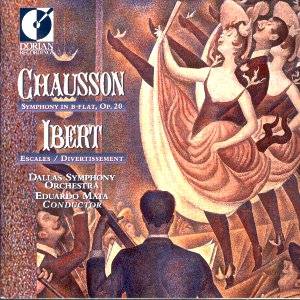Ernest CHAUSSON
(1855-1899)
Symphony in B flat Op.20 (1890)
Jacques IBERT
(1890-1962)
Escales (1922)
Divertissement
(1930)
 Dallas Symphony Orchestra/Eduardo
Mata
Dallas Symphony Orchestra/Eduardo
Mata
Recorded Dallas, January
1993
 DORIAN DOR-90181
[61:50]
DORIAN DOR-90181
[61:50]
Crotchet AmazonUK
AmazonUS

Chausson was one of these French composers known as "la bande a Franck"
for they were all his pupils and all were differently influenced by him.
Franck's influence was nevertheless a lasting one on late l9th Century French
music. (D'Indy, Fauré, Dukas, Magnard and even Roussel were influenced
at various degrees by the "Pater Seraphicus".) Chausson's only symphony,
completed in 1890, is clearly modelled on Franck's own symphony. It is in
three movements and adopts the cyclic pattern favoured by the older composer.
It is a tightly knit, closely argued piece of music of some not inconsiderable
substance. Nevertheless Chausson has a less strict approach than Franck,
and his music is less densely scored, more fanciful and at times more rhapsodic.
Moreover Chausson had a remarkable orchestral mastery, evident throughout
this symphony. This still youthful, warmly romantic symphony brims with
invention, vitality and energy, and is one of the finest late 19th Century
French symphonies.
Jacques Ibert was a gifted craftsman with a large and varied output
in almost every genre in which he rarely (if at all!) attempted at plumbing
any great depth. His finely crafted music aimed - most of the time - at
entertainment. He wrote a number of short piano pieces, ballets, orchestral
and chamber works characterised by a luminous, neo-classical style tinged
with some impressionism. Escales of 1922 may be one of his best-known
works, much to his dismay. It is a colourful travelogue around the Mediterranean
Sea, a set of vivid postcards evoking the sounds and sights of Italy, North
Africa and Spain.
The Divertissement of 1930 is a reworking for small orchestra and
piano of some incidental music written for Labiche's comedy Un Chapeau
de Paille d'Italie. The music is full of humour, alluding to salon music
and even parodying Mendelssohn's Wedding March.
Mata's performances of these highly contrasted pieces are all very fine and
he gets a fine response from his orchestra. The real problem, though, in
assessing such a hugely disparate coupling lies in the fact the Chausson
and Ibert have really nothing in common and stand poles apart from each other.
Anyway if this coupling appeals to you, you need not worry for each piece
is given a highly idiomatic reading and a warm recorded sound.
Hubert Culot

